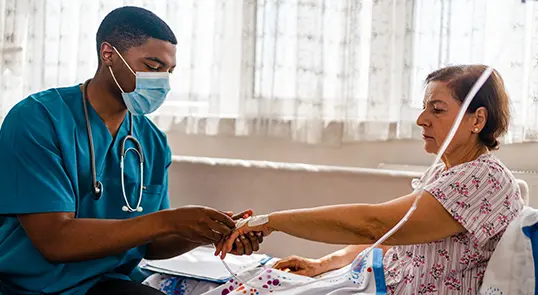
Here's what you need to know
ONCASPAR offers the option of every-2-weeks asparaginase dosing when used as part of a multicomponent chemotherapy regimen.
You will receive ONCASPAR at your healthcare professional's office and it may be given by either an injection into a muscle (intramuscular, or IM) or an infusion into a vein (intravenous, or IV).
ONCASPAR is engineered to stay in the body longer through a process called PEGylation, which means that every dose lasts longer in the fight against acute lymphoblastic leukemia (ALL).
What to expect during treatment
Some people may have allergic, nonallergic, or silent allergic reactions to ONCASPAR. Your healthcare professional may use a type of testing called therapeutic drug monitoring (TDM) to help figure out the type of reaction it was. If you have a nonallergic reaction, you may be able to continue your ONCASPAR treatment.
To lower your chances of having a reaction to ONCASPAR, your healthcare professional may use an approach called "premedication," which means you will receive medications before you start your ALL treatment. These medications may prevent or reduce allergic reaction symptoms.
One evaluation showed a 66% reduction in treatment reactions when patients were given medication before treatment.
Many patients have benefitted from the use of premedication and TDM, which are also recommended by the NCCN Clinical Practice Guidelines in Oncology (NCCN Guidelines®).*
Staying the course
Patients who remained on asparaginase treatment as part of an ALL chemotherapy regimen had significantly better survival compared with patients who stopped asparaginase treatment.
Abbreviation: NCCN, National Comprehensive Cancer Network.
Learn more about patient support resources

*Referenced with permission from the NCCN Clinical Practice Guidelines in Oncology (NCCN Guidelines®) for Acute Lymphoblastic Leukemia V.1.2022. © National Comprehensive Cancer Network, Inc. 2022. All rights reserved. Accessed July 26, 2022. To view the most recent and complete version of the guideline, go online to NCCN.org. NCCN makes no warranties of any kind whatsoever regarding their content, use or application and disclaims any responsibility for their application or use in any way.
Referenced with permission from the NCCN Clinical Practice Guidelines in Oncology (NCCN Guidelines®) for Pediatric Acute Lymphoblastic Leukemia V.2.2023. © National Comprehensive Cancer Network, Inc. 2023. All rights reserved. Accessed April 3, 2023. To view the most recent and complete version of the guideline, go online to NCCN.org.